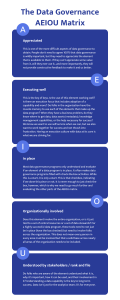
There is a vast array of opinions on topics related to building data governance and data management capabilities. So many folks who view themselves as data experts adapt to some common misconceptions many of us try to resolve.
This is part one of a two-part blog on data governance relevance. This will cover my least favorite topic or action: checkbox data governance.
Checkbox execution in data or data governance programs is a very bad thing. This blog is a cautionary tale about the practice of executing data governance with checkboxes and an area I like to use to attack core problems of underperforming data governance programs.
As I meet with companies who have ‘implemented’ data governance, often I get the answer, “we are doing data governance.” We can talk about their program, and I often figure out that someone read a book or two, read some blogs, or attended some webinars on data governance, and they think the job is done after doing a couple of the activities the experts talked about.
They treat a data governance program as a project and ask a set of questions or set up some recommended items so they can check off boxes for establishing a data council, creating a business glossary, and so on. The most advanced set of these checkboxes looks something like this:
The challenge is often that these are one-and-done actions that were felt to be completed. The use of these items is very light, and the council rarely meets or accomplishes very little. The bottom line then is that we have done these tasks, but there is little to no beneficial outcome. This is a bad thing, and this is why many firms feel like their data governance effort has been a failure.
When working on data governance, it is recommended to focus on operationalizing data. This means using the same sort of constructs as an engine but then running the engine and continuously evaluating what the outcomes are. By reviewing progress and taking into account what is being done, who is doing it, and where the trouble lies, we are in a much better position.
For about three years, largely during COVID, I was more focused on customer success than on data governance. That was a great experience. I learned much from running a customer success practice and learned how data governance could be much more successful by using some of the key functionality of customer success tools like Gainsight.
The ability to see what is needed, identify how to complete a task, see what is being done, and pinpoint what is outstanding (late) was a great piece of functionality. Further, having an aging report that would identify outstanding needs and who was working them was incredibly helpful.
To that end, I came up with an approach for data governance that has been very well received. I call it the data governance AEIOU matrix. It includes five areas to consider when implementing foundational elements of a data governance program like councils, roadmaps, and business glossaries.

The order to execute in is: (1) I – In place; (2) O – Organizationally involved; (3) U – Understood by stakeholders/rank and file; (4) A – Appreciated; (5) E – Executing well.
The goal here is to grow beyond the checkbox (or “in place” stage), bring people together, and have successful execution. It is only by bringing people together, focusing on effective execution, and sharing progress that we can have long-term success in data governance.
By growing from putting a capability in place to focusing on execution, soon your firm will grow beyond the checkbox approach to data governance and begin to become wildly successful in your data governance program. For more information on data governance, reach out to Wavicle’s experts.